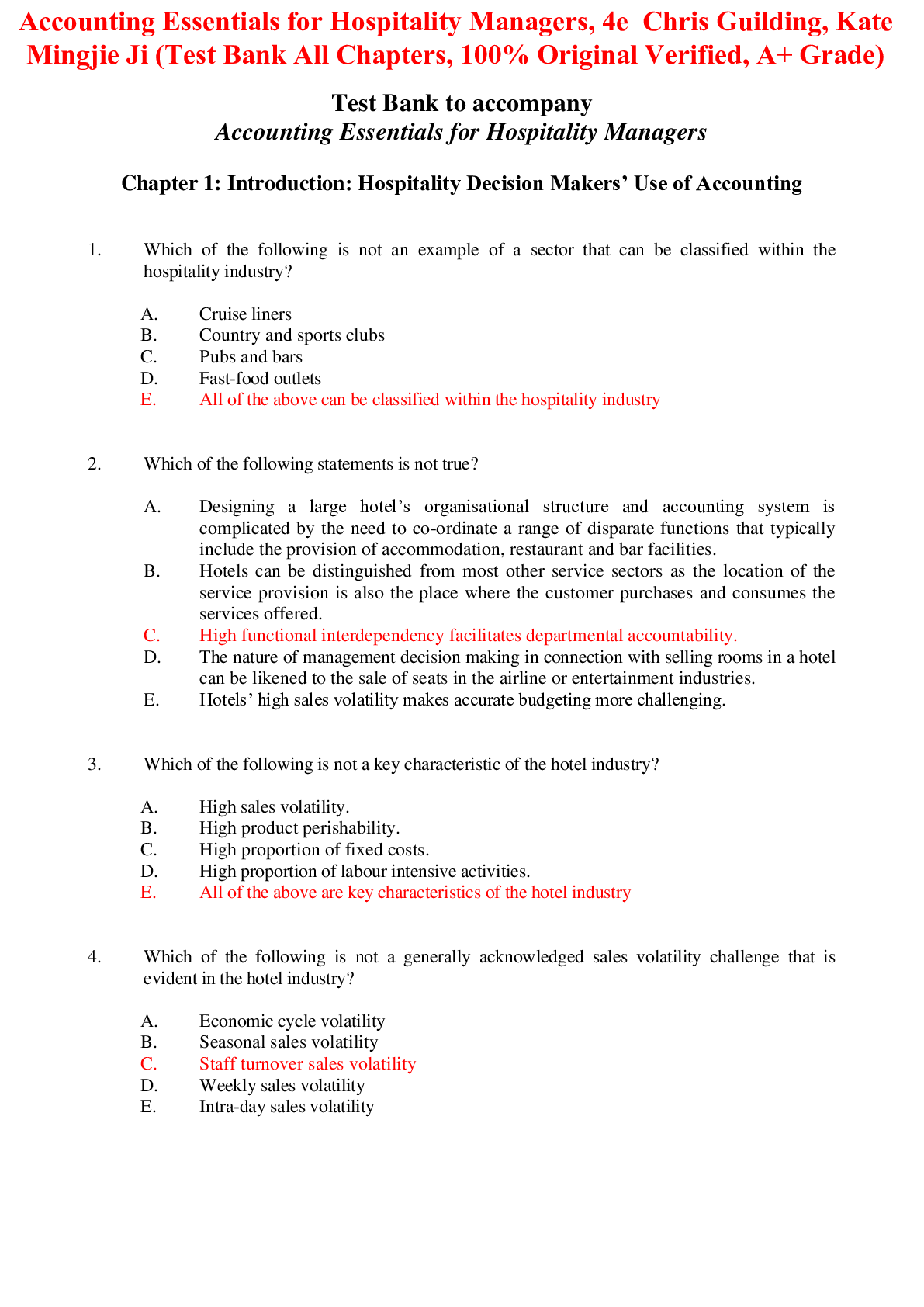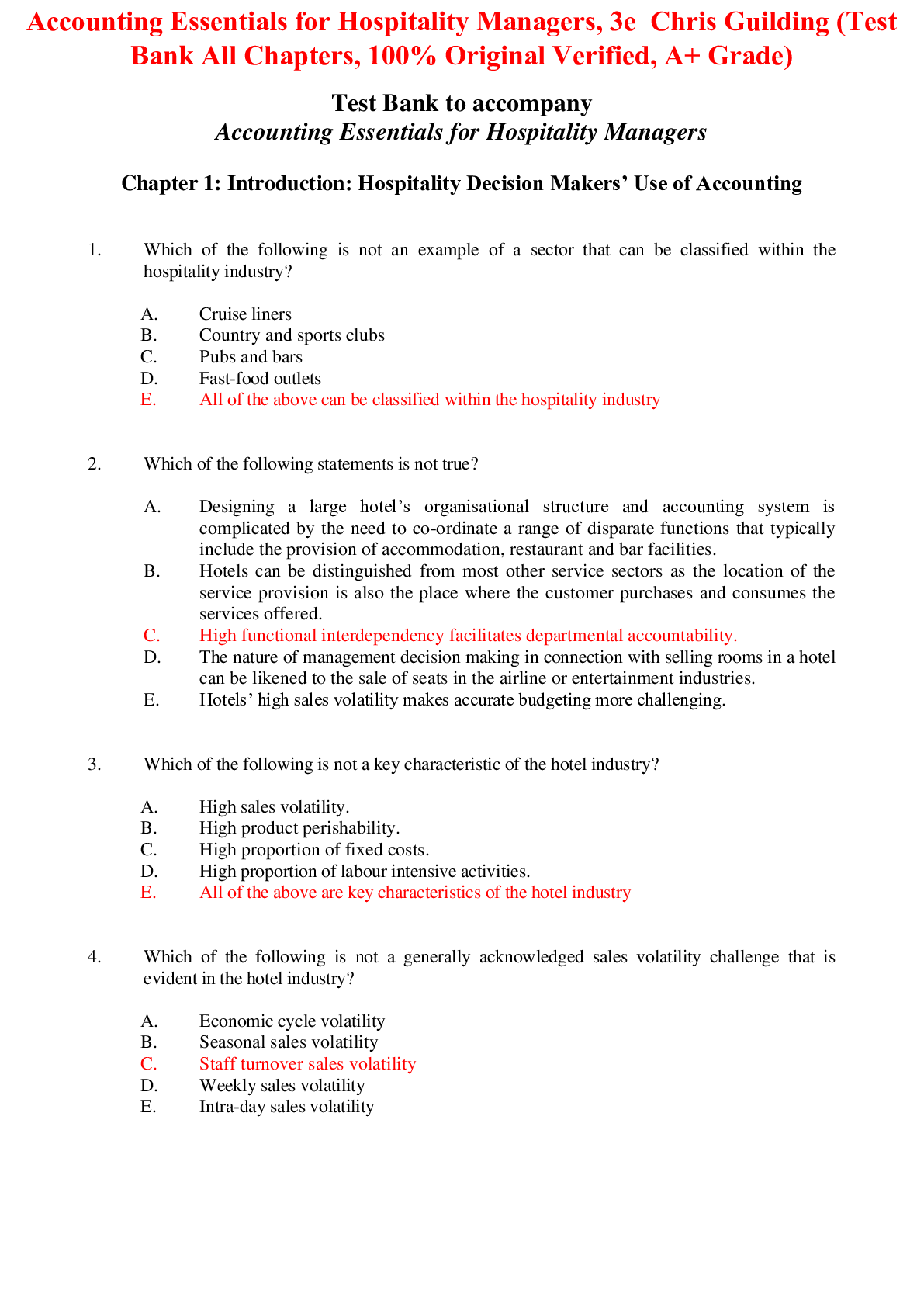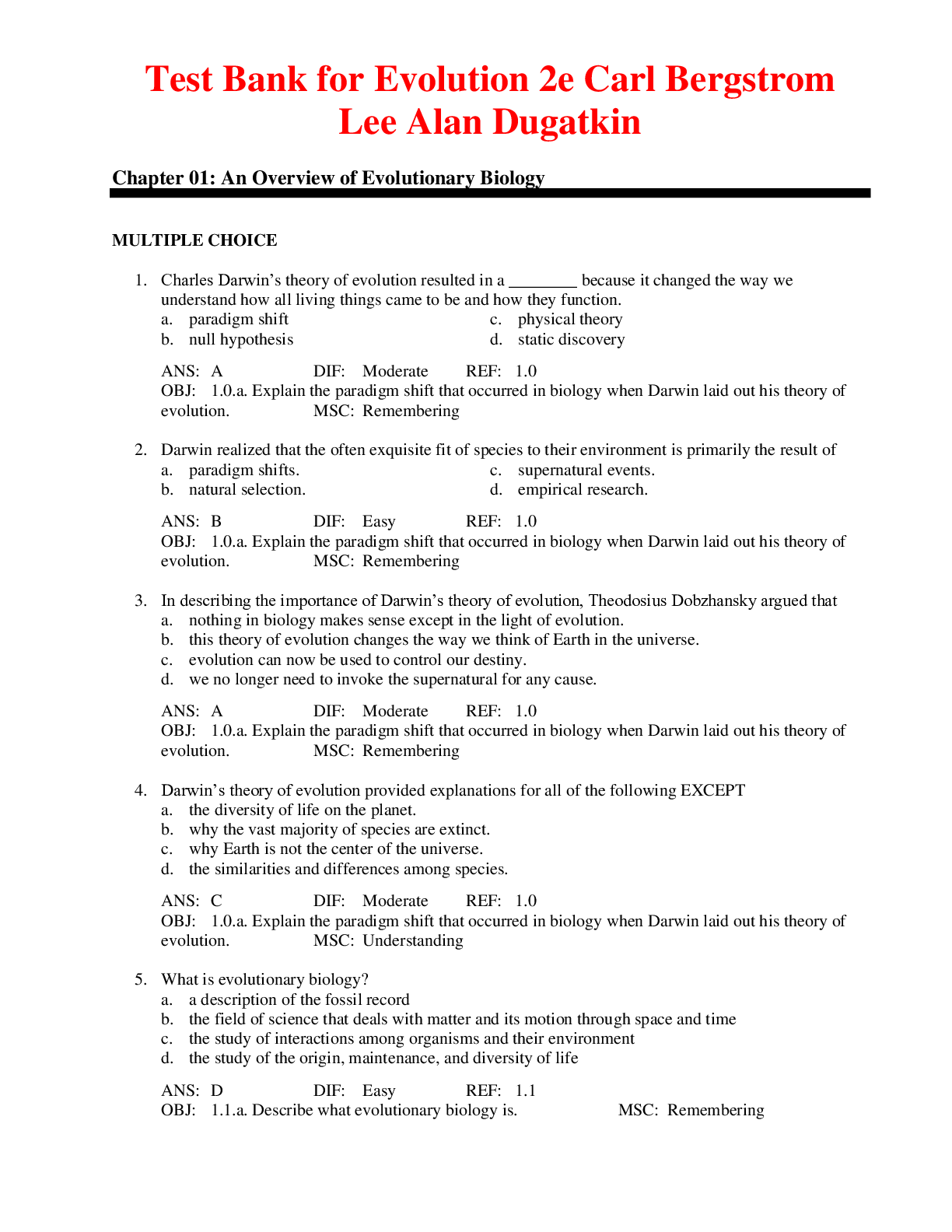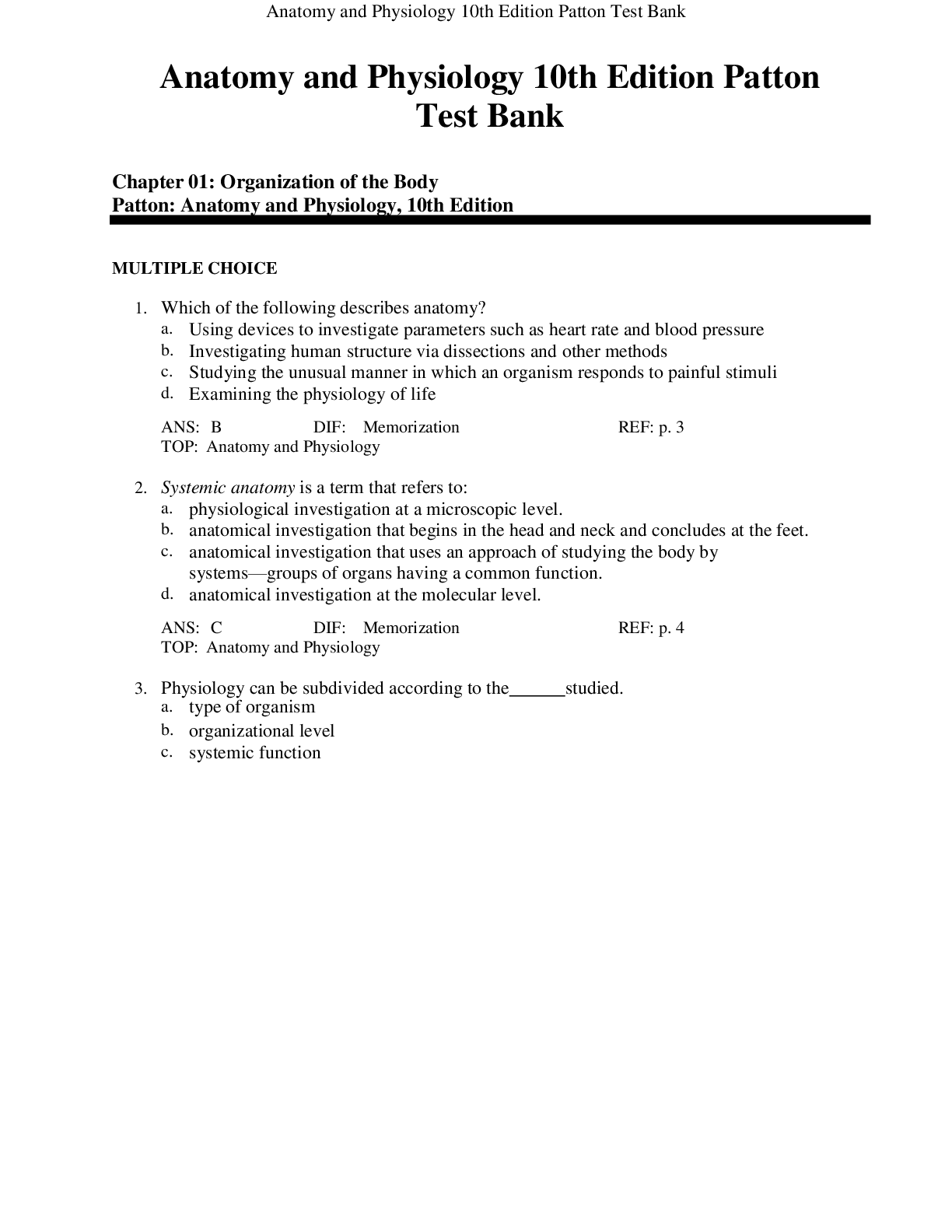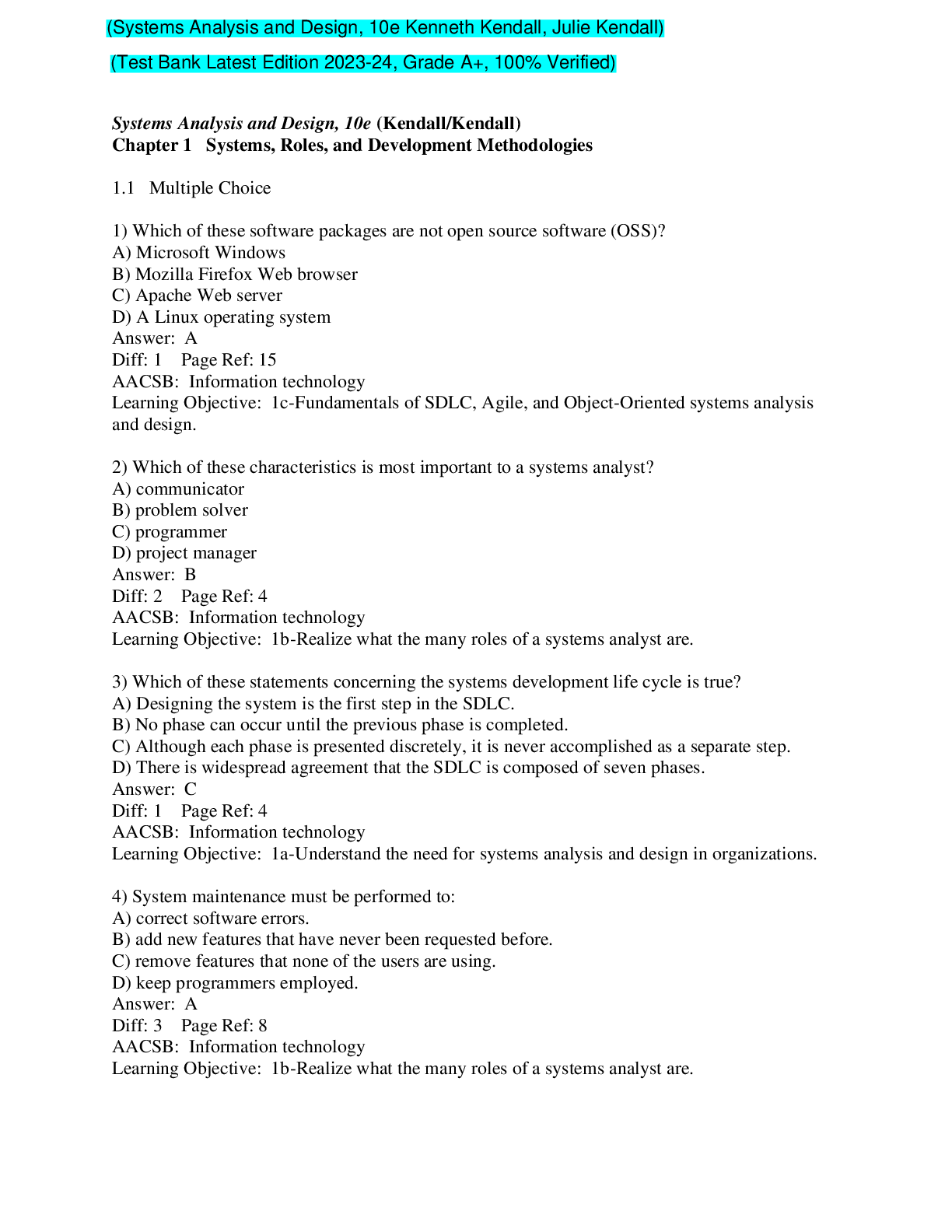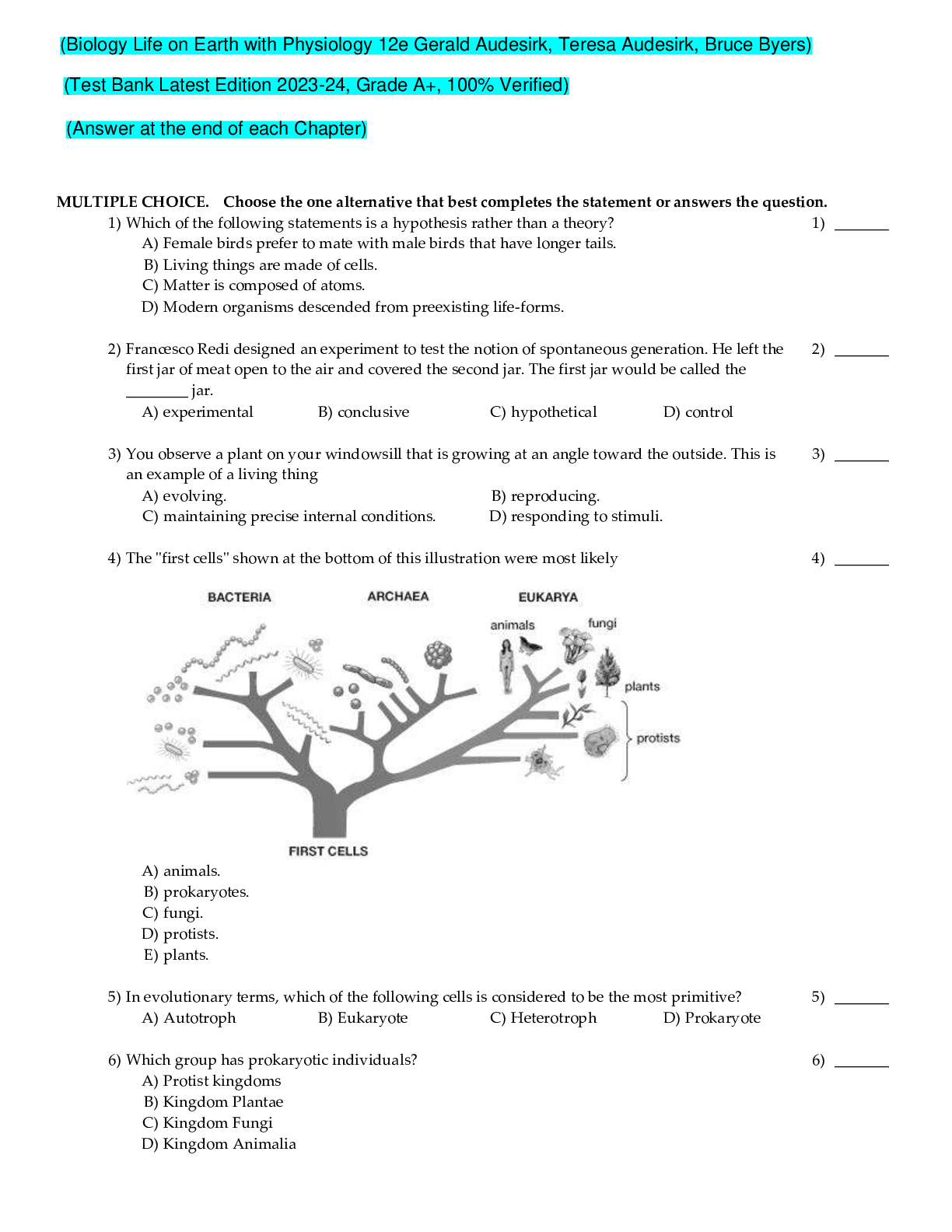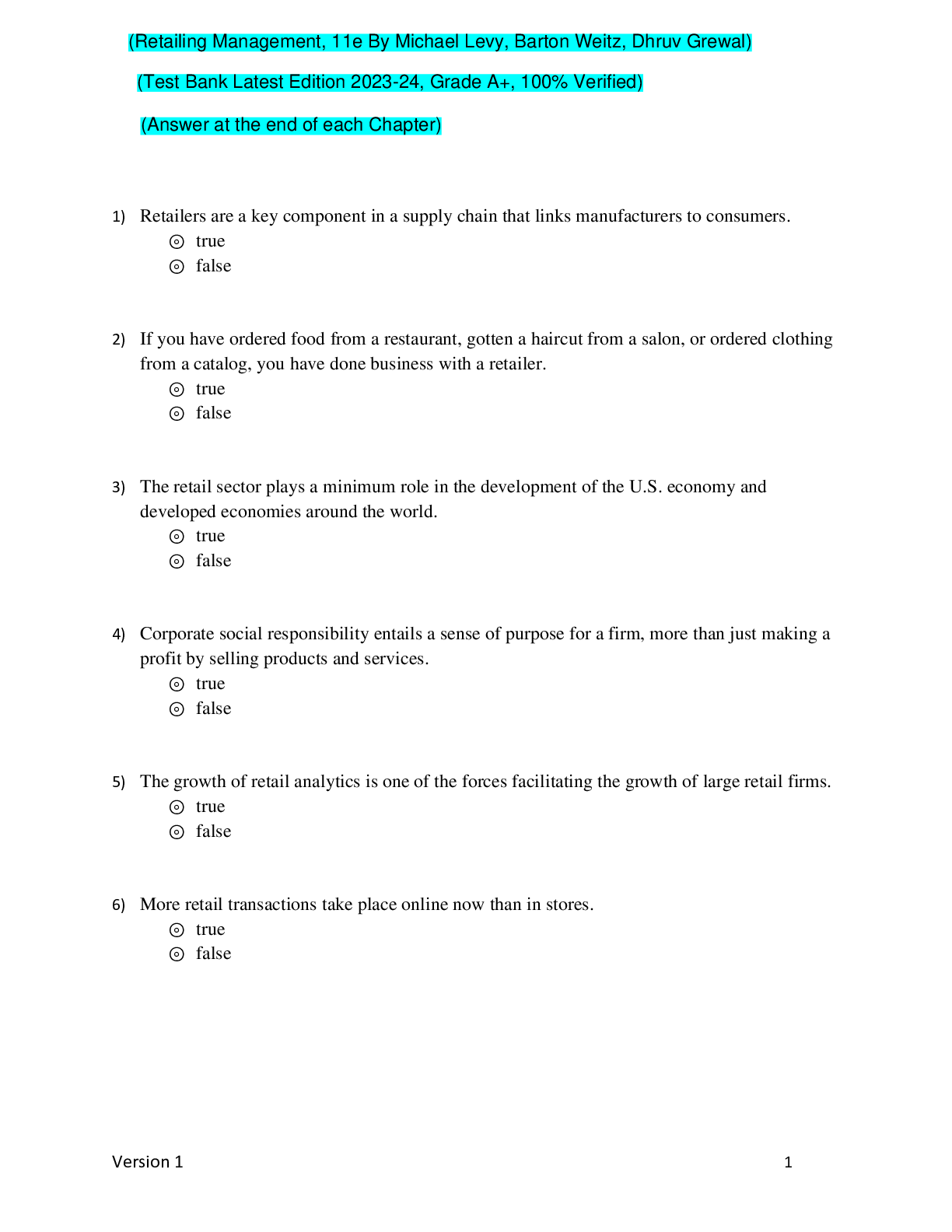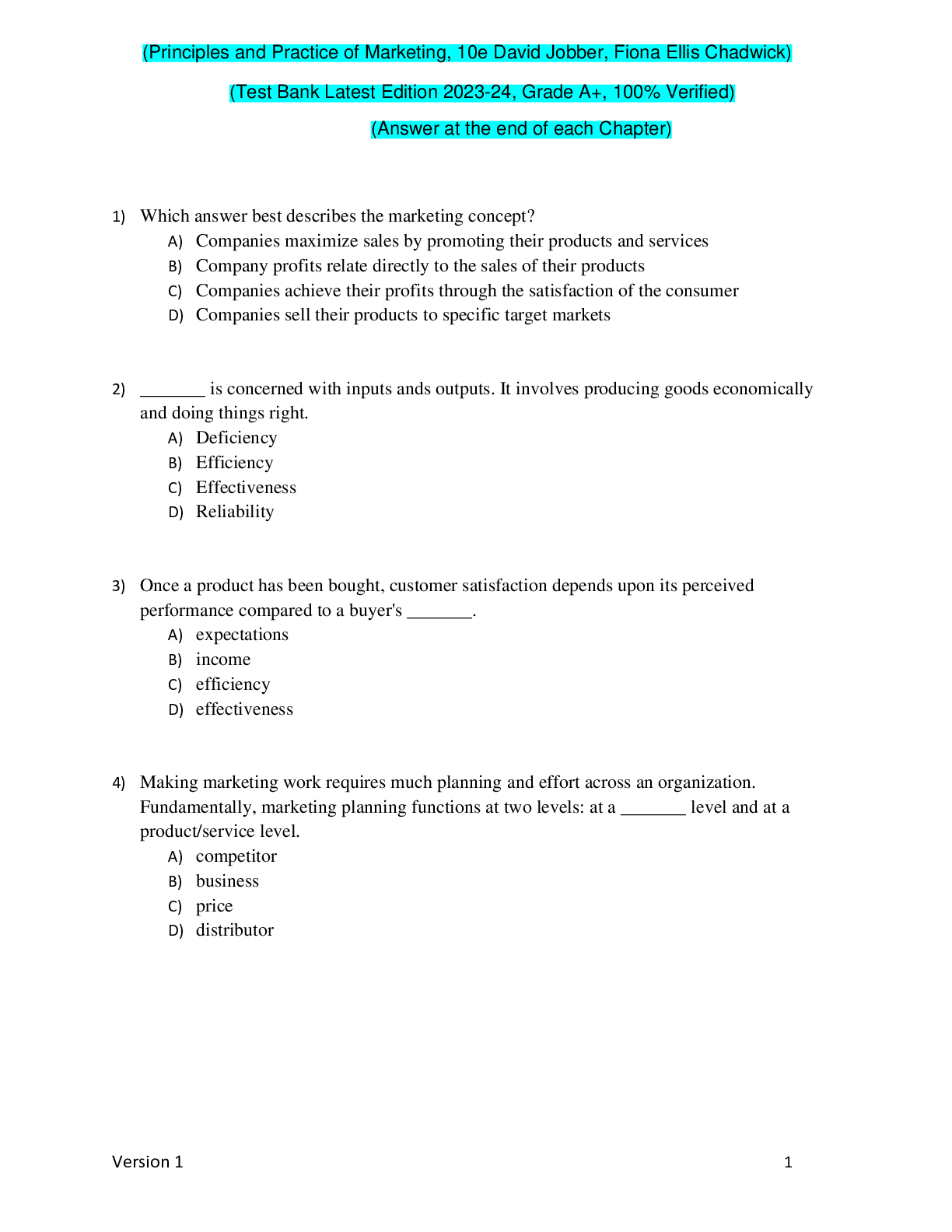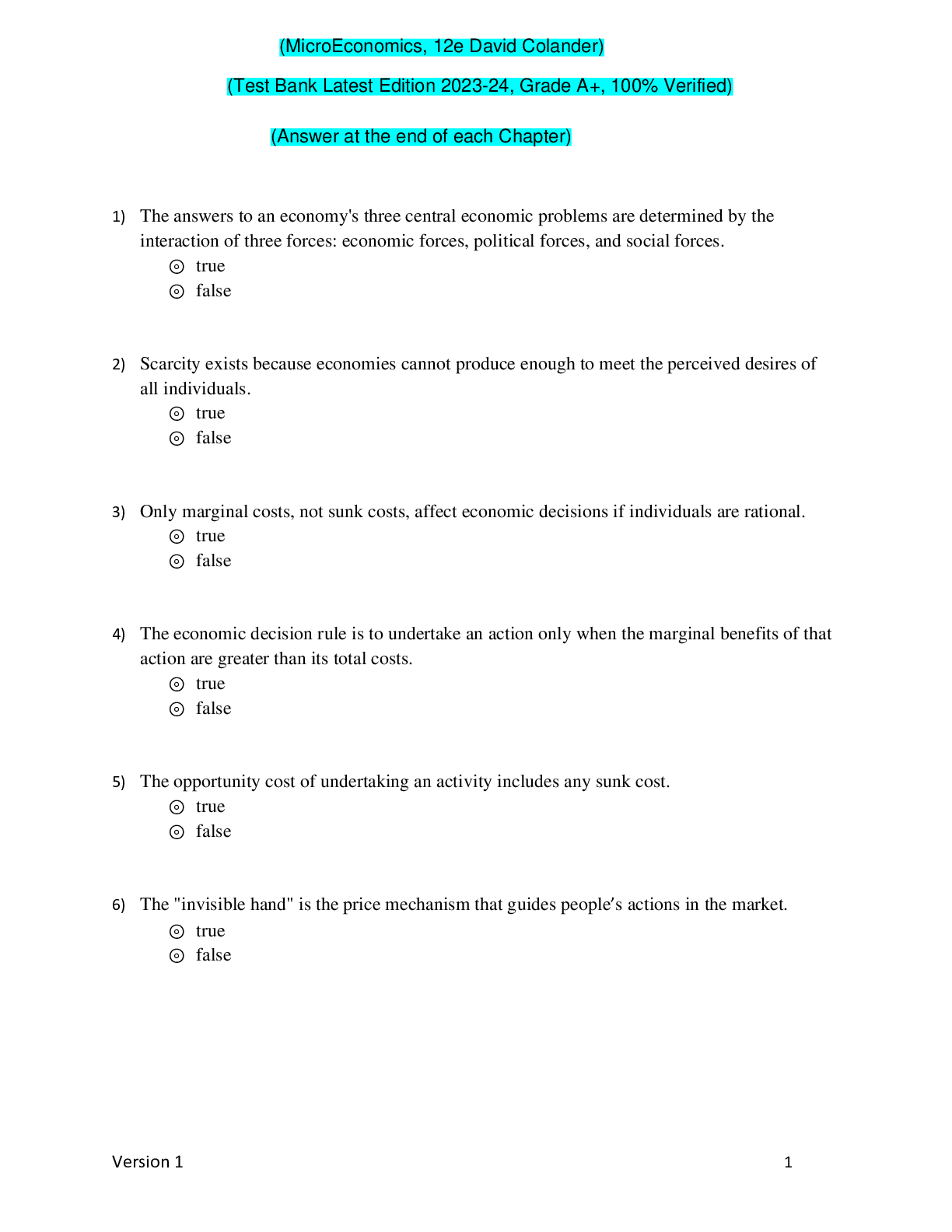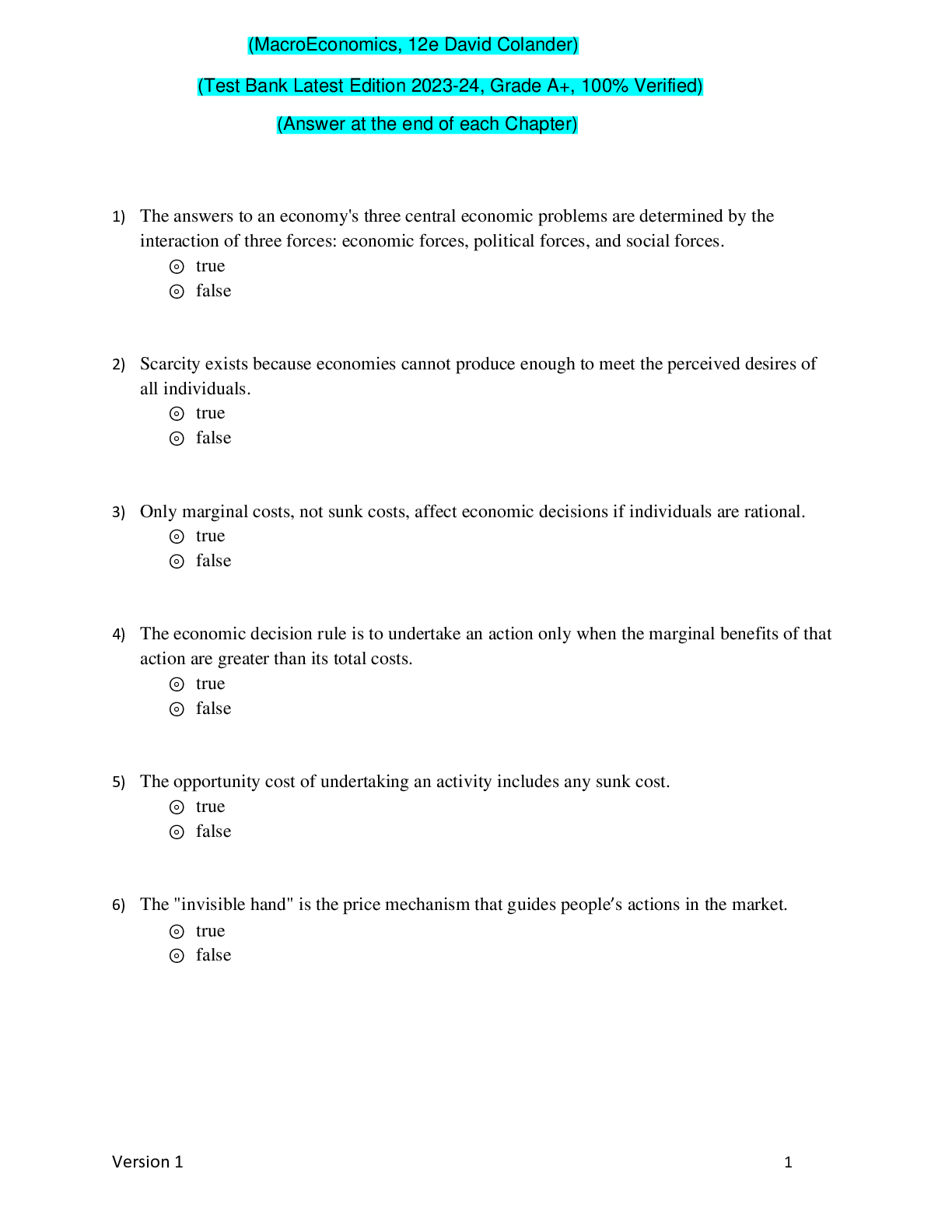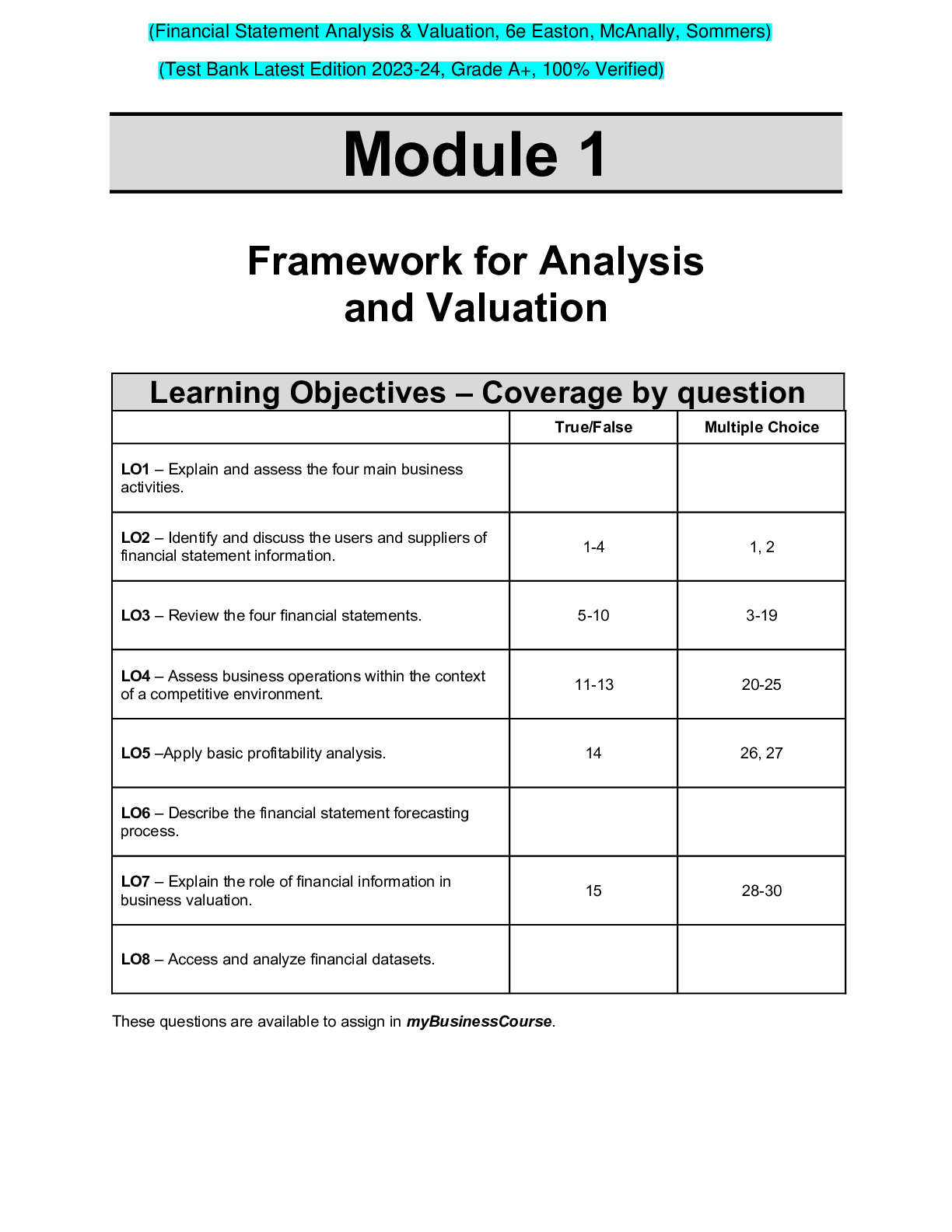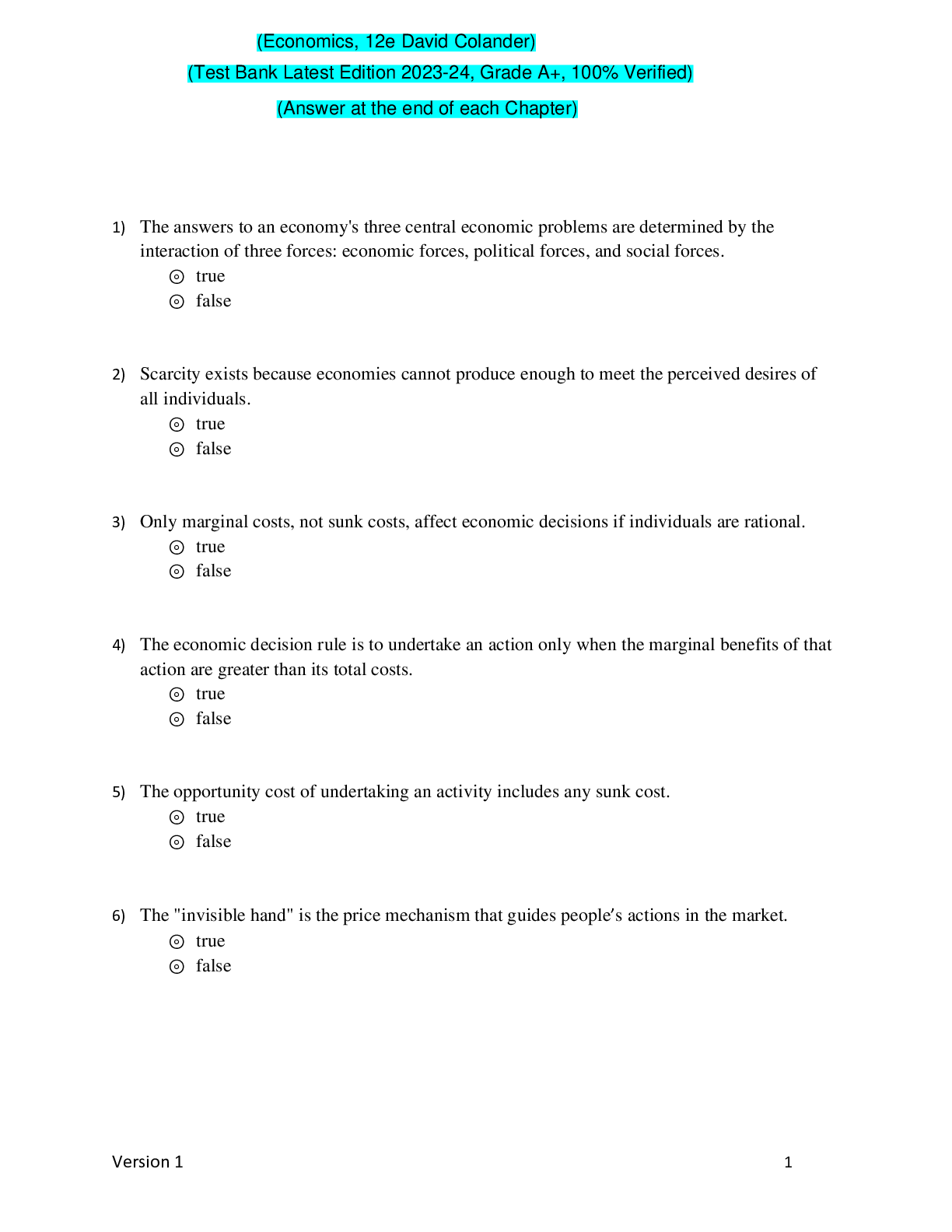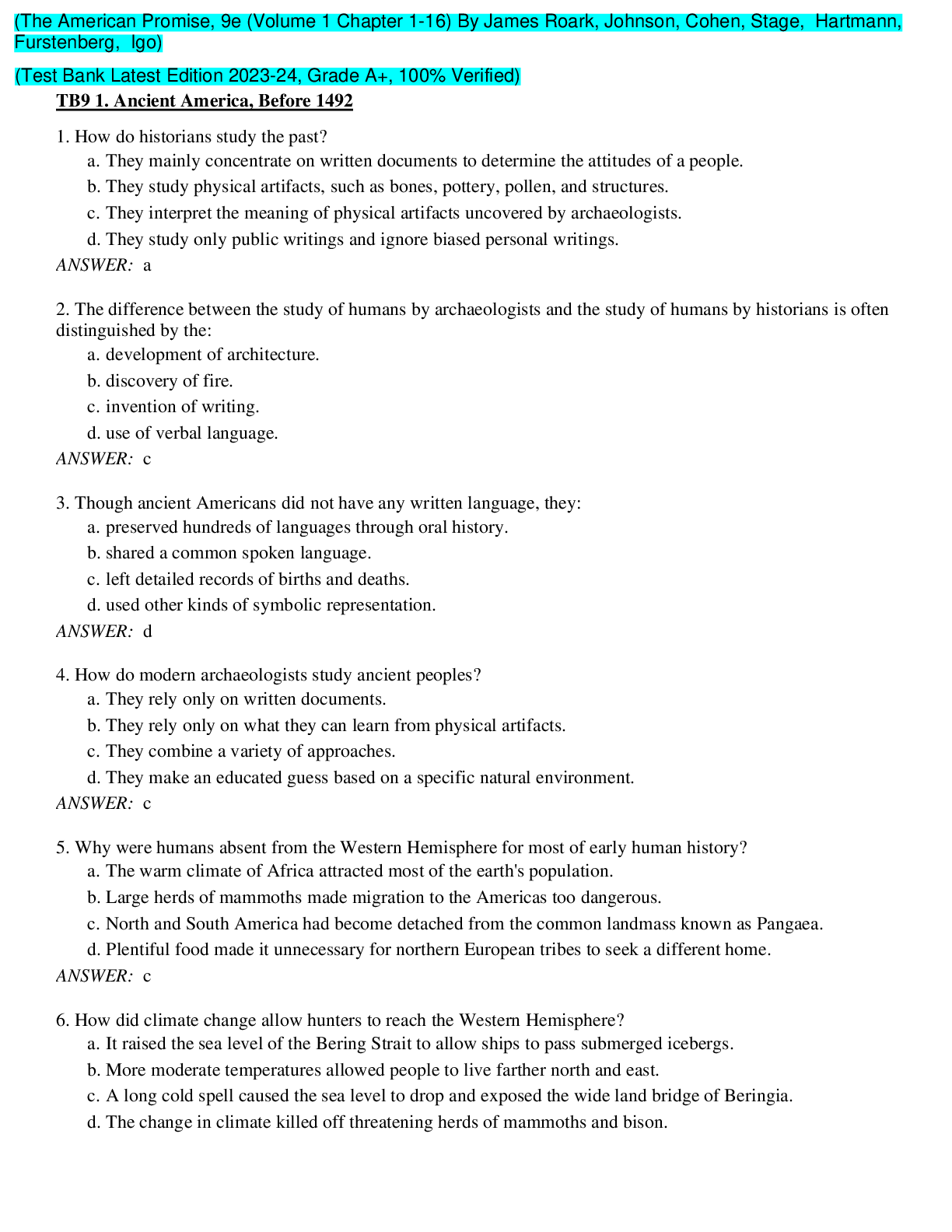Finance > TEST BANK > FIN 101 Mid Term-Financial Management Notes Questions And Answers;TOP SCORE (All)
FIN 101 Mid Term-Financial Management Notes Questions And Answers;TOP SCORE
Document Content and Description Below
1. "Capital" is sometimes defined as funds supplied to a firm by investors. T 2. The cost of capital used in capital budgeting should reflect the average cost of the various sources of long... -term funds a firm uses to acquire assets. T 3. The component costs of capital are market-determined variables in the sense that they are based on investors' required returns. T 4. Suppose you are the president of a small, publicly-traded corporation. Since you believe that your firm's stock price is temporarily depressed, all additional capital funds required during the current year will be raised using debt. In this case, the appropriate marginal cost of capital for use in capital budgeting during the current year is the after-tax cost of debt. F 5. The before-tax cost of debt, which is lower than the after-tax cost, is used as the component cost of debt for purposes of developing the firm's WACC. F 6. The cost of debt is equal to one minus the marginal tax rate multiplied by the average coupon rate on all outstanding debt. F 7. The cost of debt is equal to one minus the marginal tax rate multiplied by the interest rate on new debt. T 8. The cost of preferred stock to a firm must be adjusted to an after-tax figure because 70% of dividends received by a corporation may be excluded from the receiving corporation's taxable income. F 9. The cost of perpetual preferred stock is found as the preferred's annual dividend divided by the market price of the preferred stock. No adjustment is needed for taxes because preferred dividends, unlike interest on debt, is not deductible by the issuing firm. T 10. The cost of common equity obtained by retaining earnings is the rate of return the marginal stockholder requires on the firm's common stock. T 11. For capital budgeting and cost of capital purposes, the firm should always consider reinvested earnings as the first source of capital⎯i.e., use these funds first⎯because reinvested earnings have no cost to the firm. F 12. Funds acquired by the firm through retaining earnings have no cost because there are no dividend or interest payments associated with them, and no flotation costs are required to raise them, but capital raised by selling new stock or bonds does have a cost. F 13. The cost of equity raised by retaining earnings can be less than, equal to, or greater than the cost of external equity raised by selling new issues of common stock, depending on tax rates, flotation costs, the attitude of investors, and other factors. F 14. The firm's cost of external equity raised by issuing new stock is the same as the required rate of return on the firm's outstanding common stock. F 15. The higher the firm's flotation cost for new common equity, the more likely the firm is to use preferred stock, which has no flotation cost, and reinvested earnings, whose cost is the average return on the assets that are acquired. F 16. For capital budgeting and cost of capital purposes, the firm should assume that each dollar of capital is obtained in accordance with its target capital structure, which for many firms means partly as debt, partly as preferred stock, and partly common equity. T 17. In general, firms should use their weighted average cost of capital (WACC) to evaluate capital budgeting projects because most projects are funded with general corporate funds, which come from a variety of sources. However, if the firm plans to use only debt or only equity to fund a particular project, it should use the after-tax cost of that specific type of capital to evaluate that project. ANS: F In general, this statement is false, because the firm should be viewed as an ongoing entity, and using debt (or equity) to fund a given project will change the capital structure, and this factor should be recognized by basing the cost of capital for all projects on a target capital structure. Under some special circumstances, where a project is set up as a separate entity, then "project financing" may be used, and only the project's specific situation is considered. This is a specific situation, however, and not the "in general" case. 18. If a firm's marginal tax rate is increased, this would, other things held constant, lower the cost of debt used to calculate its WACC. T 19. The reason why reinvested earnings have a cost equal to rs is because investors think they can (i.e., expect to) earn rs on investments with the same risk as the firm's common stock, and if the firm does not think that it can earn rs on the earnings that it retains, it should distribute those earnings to its investors. Thus, the cost of reinvested earnings is based on the opportunity cost principle. T 20. When estimating the cost of equity by use of the CAPM, three potential problems are (1) whether to use long-term or short-term rates for rRF, (2) whether or not the historical beta is the beta that investors use when evaluating the stock, and (3) how to measure the market risk premium, RPM. These problems leave us unsure of the true value of rs. T 21. When estimating the cost of equity by use of the DCF method, the single biggest potential problem is to determine the growth rate that investors use when they estimate a stock's expected future rate of return. This problem leaves us unsure of the true value of rs. T 22. When estimating the cost of equity by use of the bond-yield-plus-riskpremium method, we can generally get a good idea of the interest rate on new long-term debt, but we cannot be sure that the risk premium we add is appropriate. This problem leaves us unsure of the true value of rs. T 23. The cost of external equity capital raised by issuing new common stock (re) is defined as follows, in words: "The cost of external equity equals the cost of equity capital from retaining earnings (rs), divided by one minus the percentage flotation cost required to sell the new stock, (1 − F)." ANS: F This statement is true only if the expected growth rate is zero. Here are some illustrative numbers that show that the statement is true if g = 0 but false otherwise. 24. If the expected dividend growth rate is zero, then the cost of external equity capital raised by issuing new common stock (re) is equal to the cost of equity capital from retaining earnings (rs) divided by one minus the percentage flotation cost required to sell the new stock, (1 − F). If the expected growth rate is not zero, then the cost of external equity must be found using a different formula. ANS: T This statement is true. Here are some illustrative numbers to demonstrate this point. 25. Suppose the debt ratio (D/TA) is 50%, the interest rate on new debt is 8%, the current cost of equity is 16%, and the tax rate is 40%. An increase in the debt ratio to 60% would decrease the weighted average cost of capital (WACC). F 26. Firms raise capital at the total corporate level by retaining earnings and by obtaining funds in the capital markets. They then provide funds to their different divisions for investment in capital projects. The divisions may vary in risk, and the projects within the divisions may also vary in risk. Therefore, it is conceptually correct to use different risk-adjusted costs of capital for different capital budgeting projects. T 27. If a firm is privately owned, and its stock is not traded in public markets, then we cannot measure its beta for use in the CAPM model, we cannot observe its stock price for use in the DCF model, and we don't know what the risk premium is for use in the bond-yield-plus-risk-premium method. All this makes it especially difficult to estimate the cost of equity for a private company. ANS: T True, but data on comparable publicly owned firms can often be obtained and used as proxies for private firms. 28. The cost of debt, rd, is normally less than rs, so rd(1 − T) will normally be much less than rs. Therefore, as long as the firm is not completely debt financed, the weighted average cost of capital (WACC) will normally be greater than rd(1 − T). T 29. The lower the firm's tax rate, the lower will be its after-tax cost of debt and also its WACC, other things held constant. F 30. The text identifies three methods for estimating the cost of common stock from reinvested earnings (not newly issued stock): the CAPM method, the DCF method, and the bond-yield-plus-risk-premium method. However, only the DCF method is widely used in practice. F 31. The text identifies three methods for estimating the cost of common stock from reinvested earnings (not newly issued stock): the CAPM method, the DCF method, and the bond-yield-plus-risk-premium method. However, only the CAPM method always provides an accurate and reliable estimate. ANS: F None of the methods always provides accurate and reliable estimates. With the CAPM, we don't know the beta that investors are using, we are not totally sure of what rRF to use, and we don't know if the CAPM is truly correct. 32. The text identifies three methods for estimating the cost of common stock from reinvested earnings (not newly issued stock): the CAPM method, the DCF method, and the bond-yield-plus-risk-premium method. Since we cannot be sure that the estimate obtained with any of these methods is correct, it is often appropriate to use all three methods, then consider all three estimates, and end up using a judgmental estimate when calculating the WACC. T 33. Since 70% of the preferred dividends received by a corporation are excluded from taxable income, the component cost of equity for a company that pays half of its earnings out as common dividends and half as preferred dividends should, theoretically, be Cost of equity = rs(0.30)(0.50) + rps(1 − T)(0.70)(0.50). ANS: F The preferred dividend exclusion is a benefit to the holder of the preferred, not the issuer; hence, this statement is not true. It actually is just nonsense anyway! 34. If expectations for long-term inflation rose, but the slope of the SML remained constant, this would have a greater impact on the required rate of return on equity, rs, than on the interest rate on long-term debt, rd, for most firms. Therefore, the percentage point increase in the cost of equity would be greater than the increase in the interest rate on long-term debt. ANS: F Increased inflation results in a parallel upward shift in the SML, which means equal percentage increases in the required return on debt and equity. 35. If investors' aversion to risk rose, causing the slope of the SML to increase, this would have a greater impact on the required rate of return on equity, rs, than on the interest rate on long-term debt, rd, for most firms. Other things held constant, this would lead to an increase in the use of debt and a decrease in the use of equity. However, other things would not stay constant if firms used a lot more debt, as that would increase the riskiness of both debt and equity and thus limit the shift toward debt. T 36. Which of the following is NOT a capital component when calculating the weighted average cost of capital (WACC) for use in capital budgeting? a. Accounts payable. b. Common stock "raised" by reinvesting earnings. c. Common stock raised by new issues. d. Preferred stock. e. Long-term debt. A 37. With its current financial policies, Flagstaff Inc. will have to issue new common stock to fund its capital budget. Since new stock has a higher cost than reinvested earnings, Flagstaff would like to avoid issuing new stock. Which of the following actions would REDUCE its need to issue new common stock? a. Increase the percentage of debt in the target capital structure. b. Increase the proposed capital budget. c. Reduce the amount of short-term bank debt in order to increase the current ratio. d. Reduce the percentage of debt in the target capital structure. e. Increase the dividend payout ratio for the upcoming year. ANS: A Statement a is correct, because if more debt is used, then less equity will be needed to fund the capital budget, so the need for a stock issue would be reduced. 38. Burnham Brothers Inc. has no retained earnings since it has always paid out all of its earnings as dividends. This same situation is expected to persist in the future. The company uses the CAPM to calculate its cost of equity, and its target capital structure consists of common stock, preferred stock, and debt. Which of the following events would REDUCE its WACC? [Show More]
Last updated: 11 months ago
Preview 1 out of 300 pages
.png)
Reviews( 0 )
Document information
Connected school, study & course
About the document
Uploaded On
Mar 02, 2022
Number of pages
300
Written in
Additional information
This document has been written for:
Uploaded
Mar 02, 2022
Downloads
0
Views
27


.png)
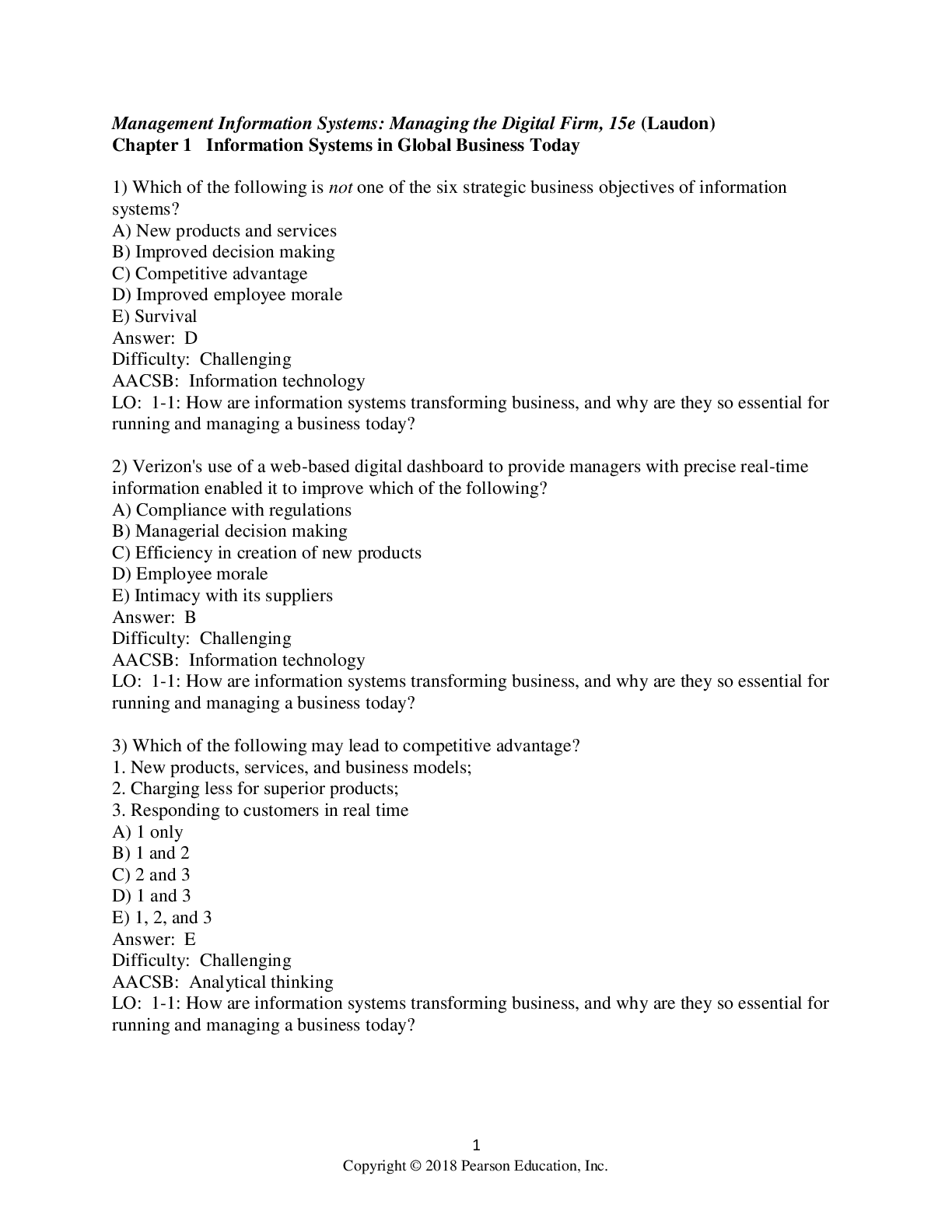
.png)
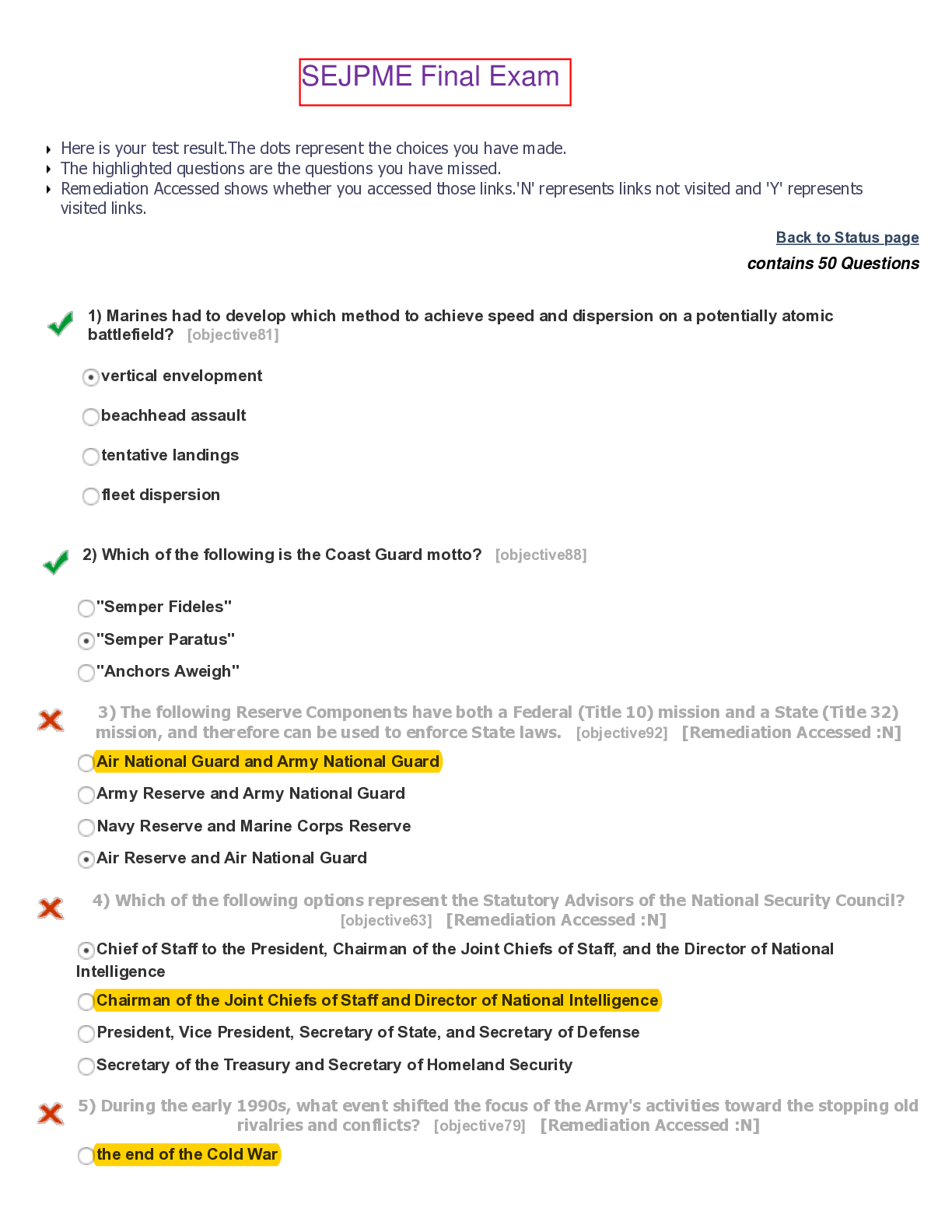

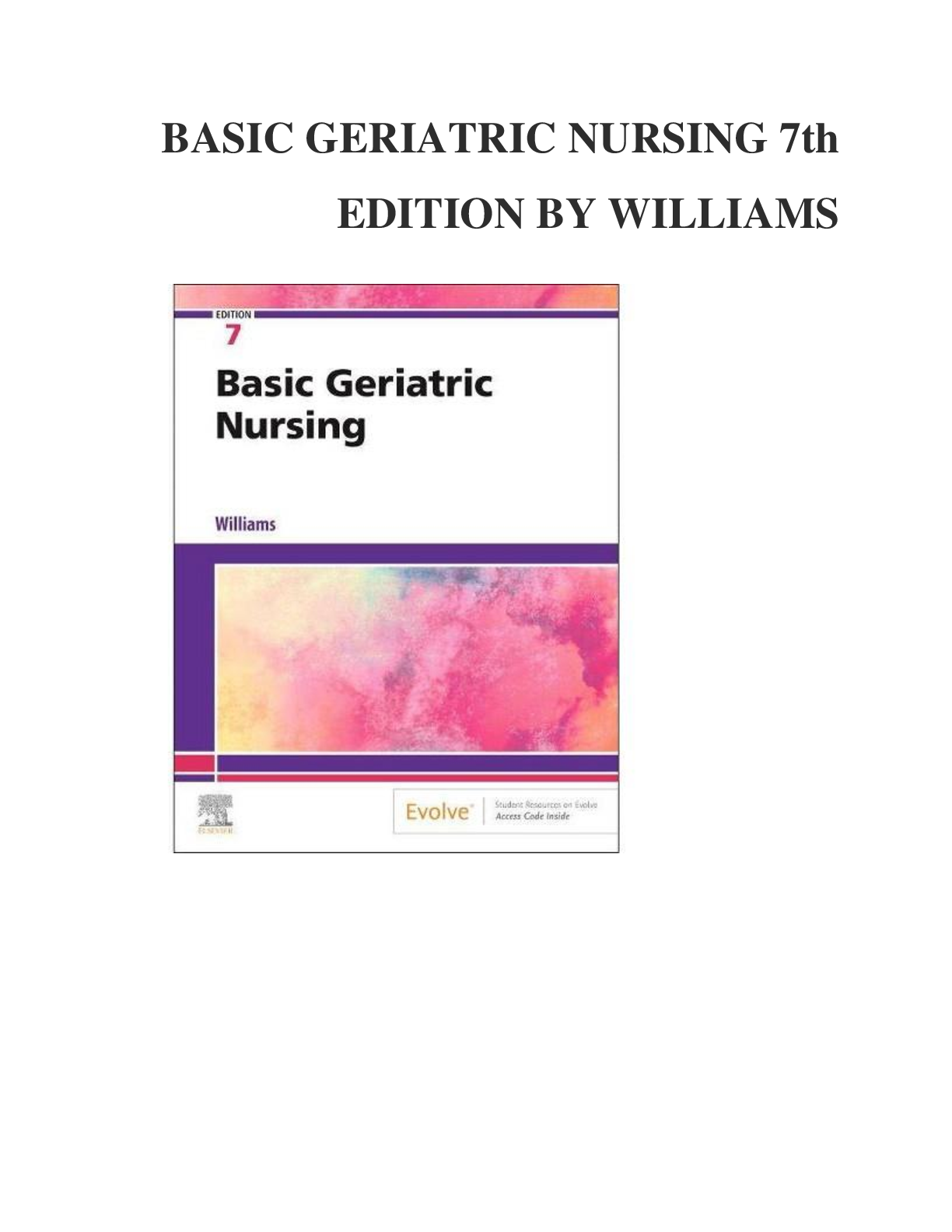
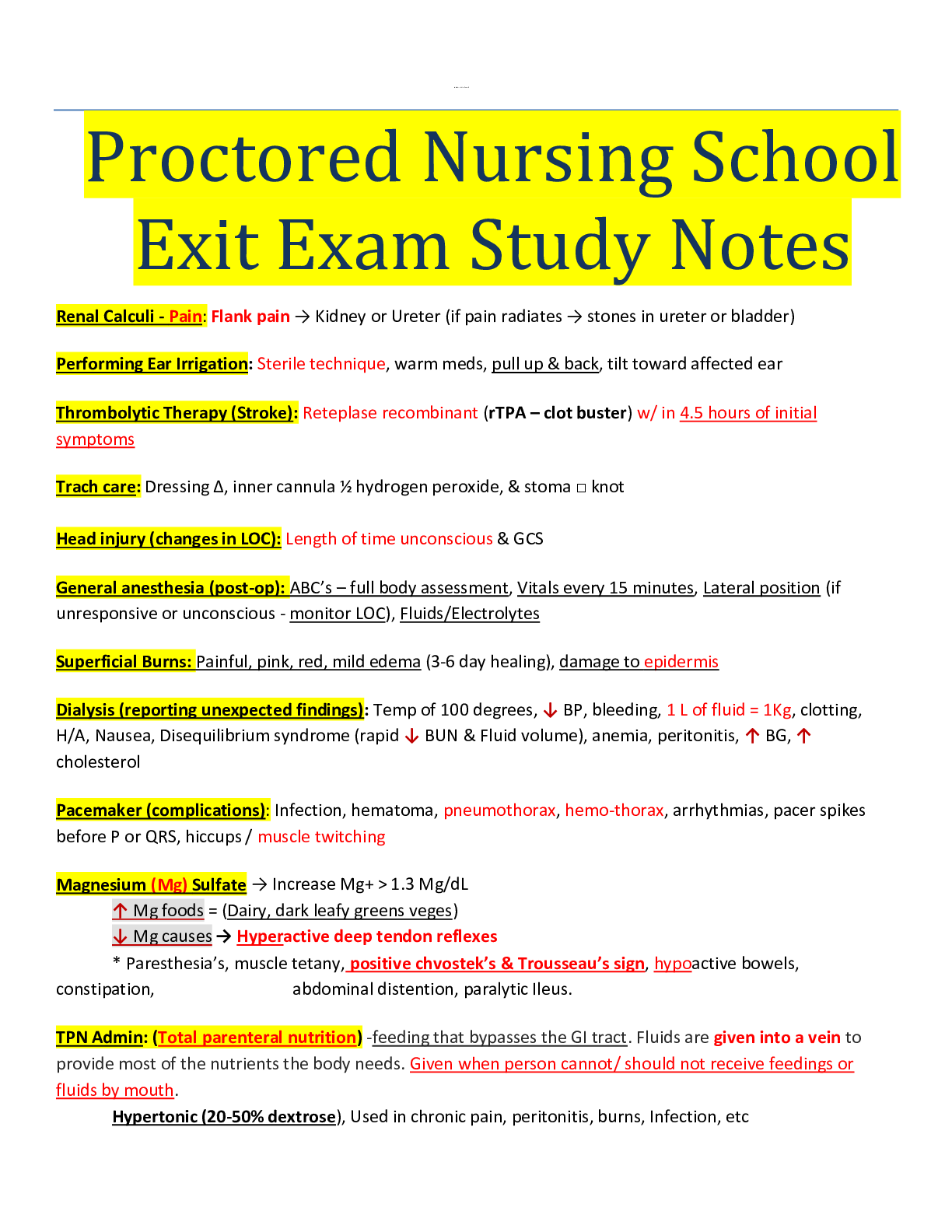
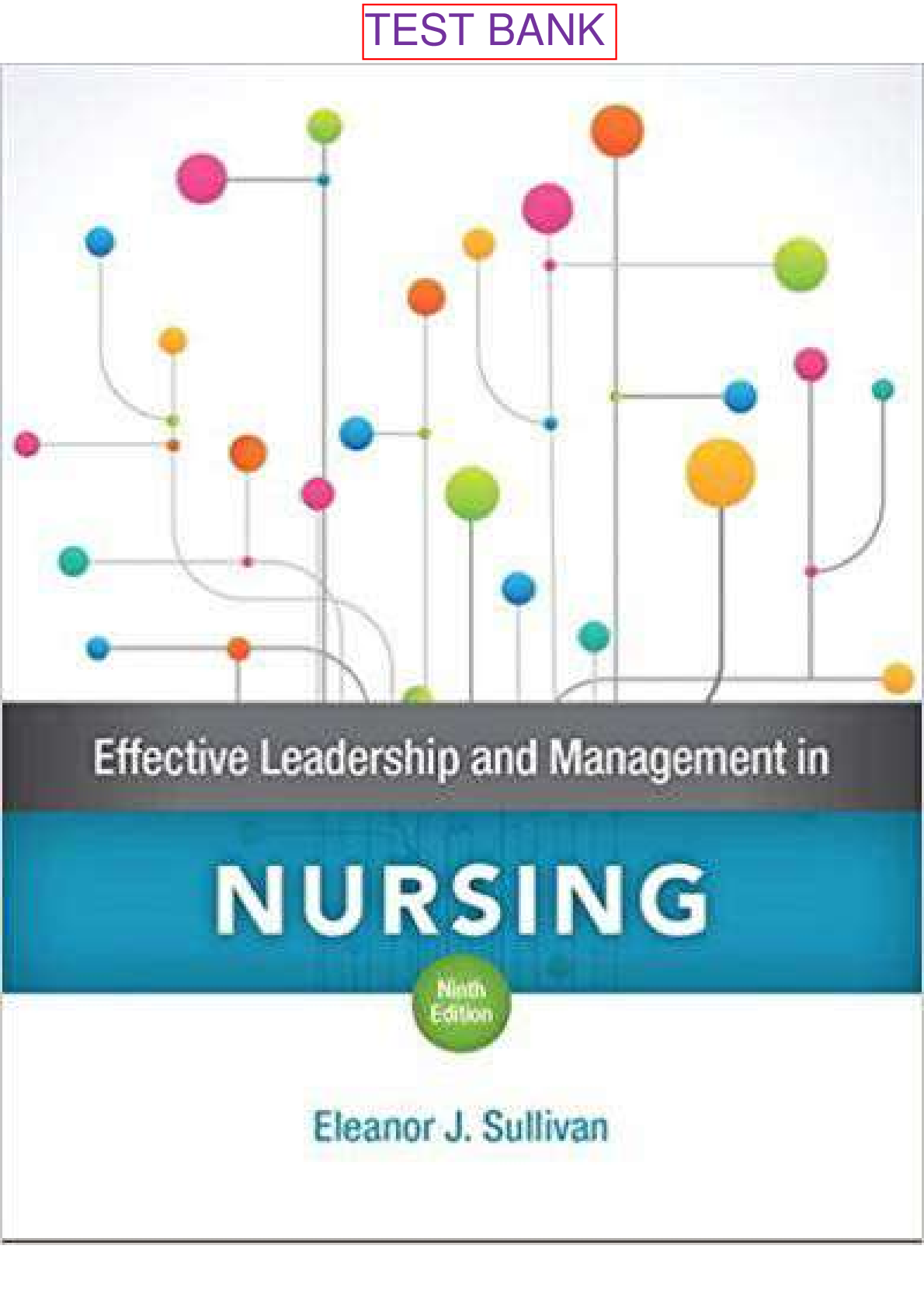
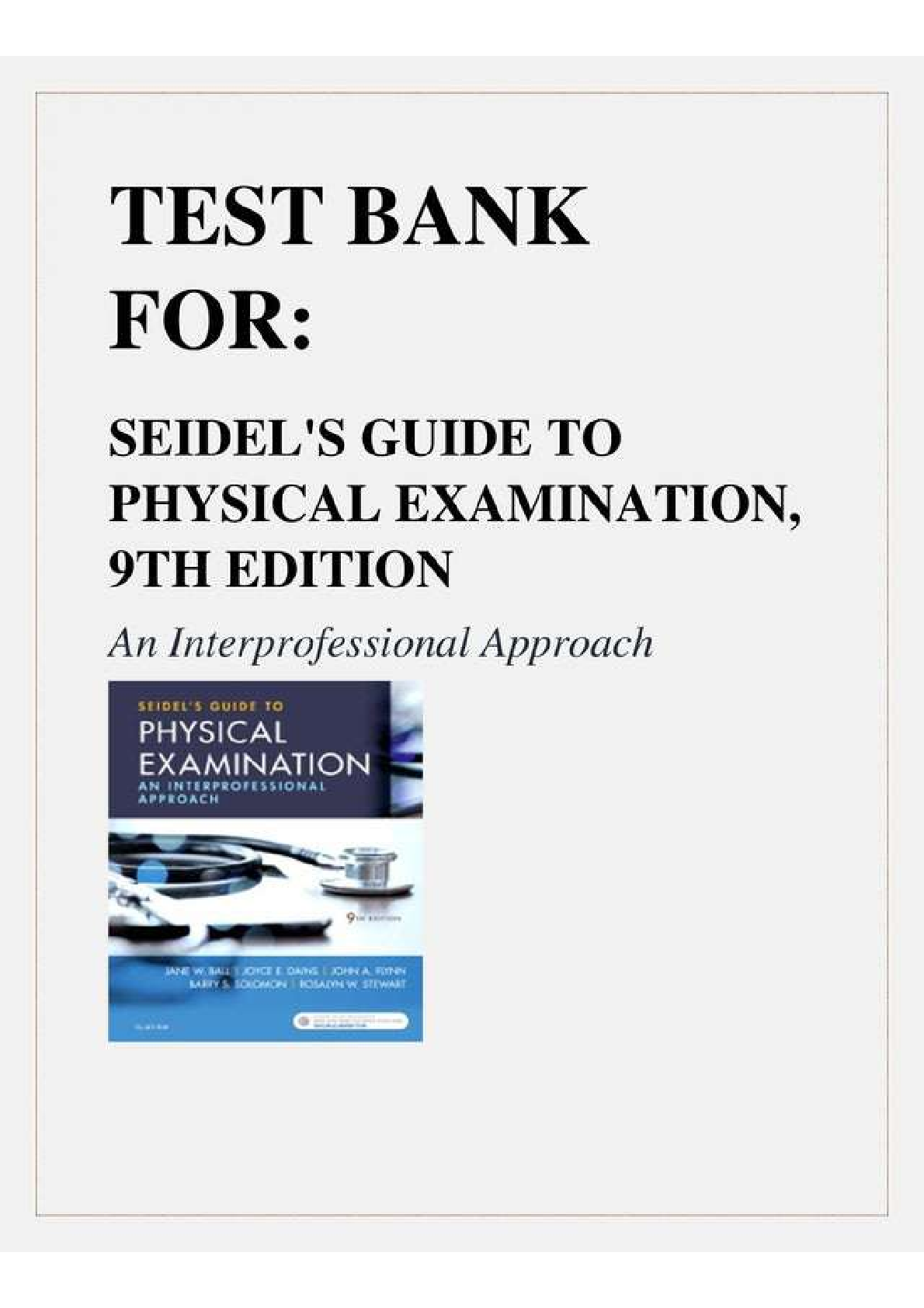
.png)

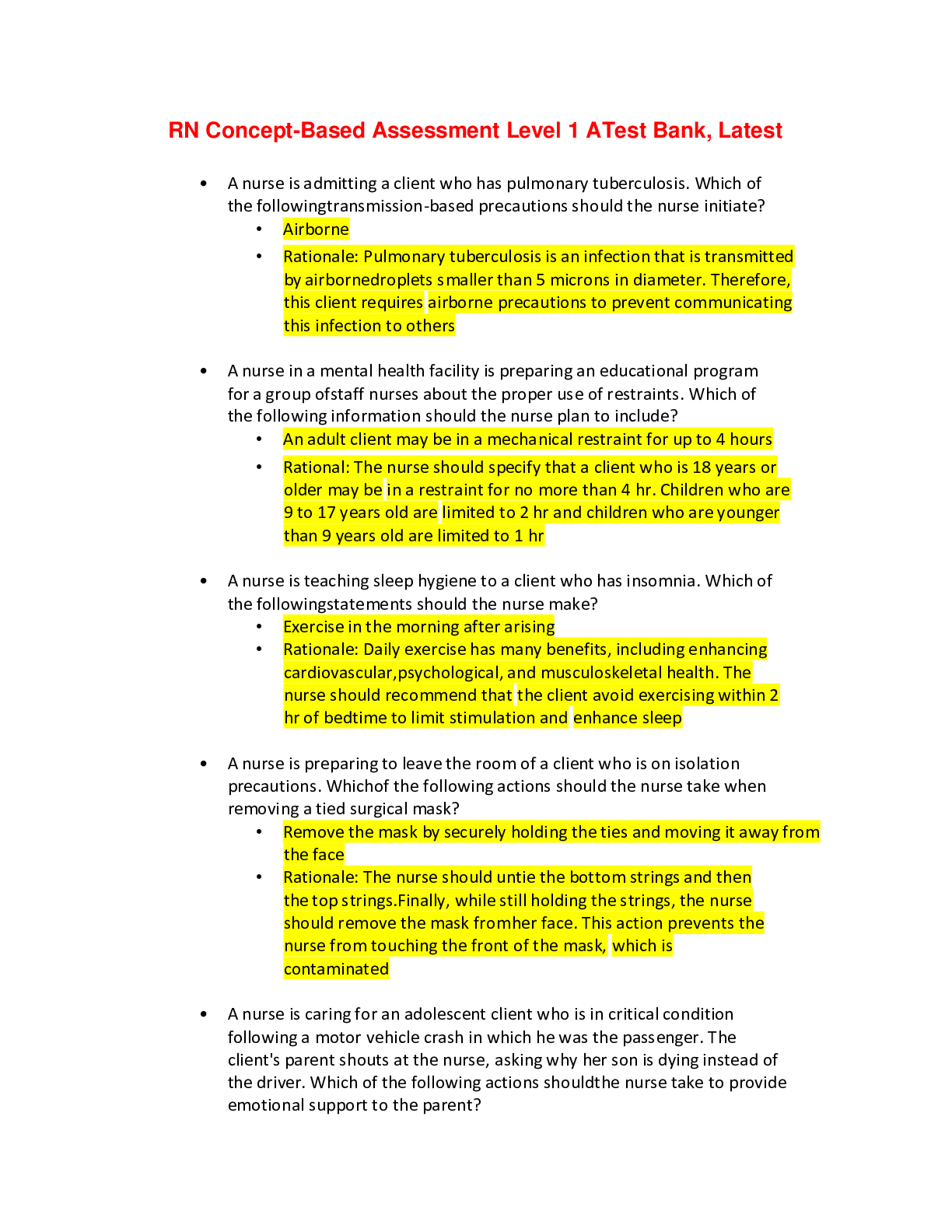
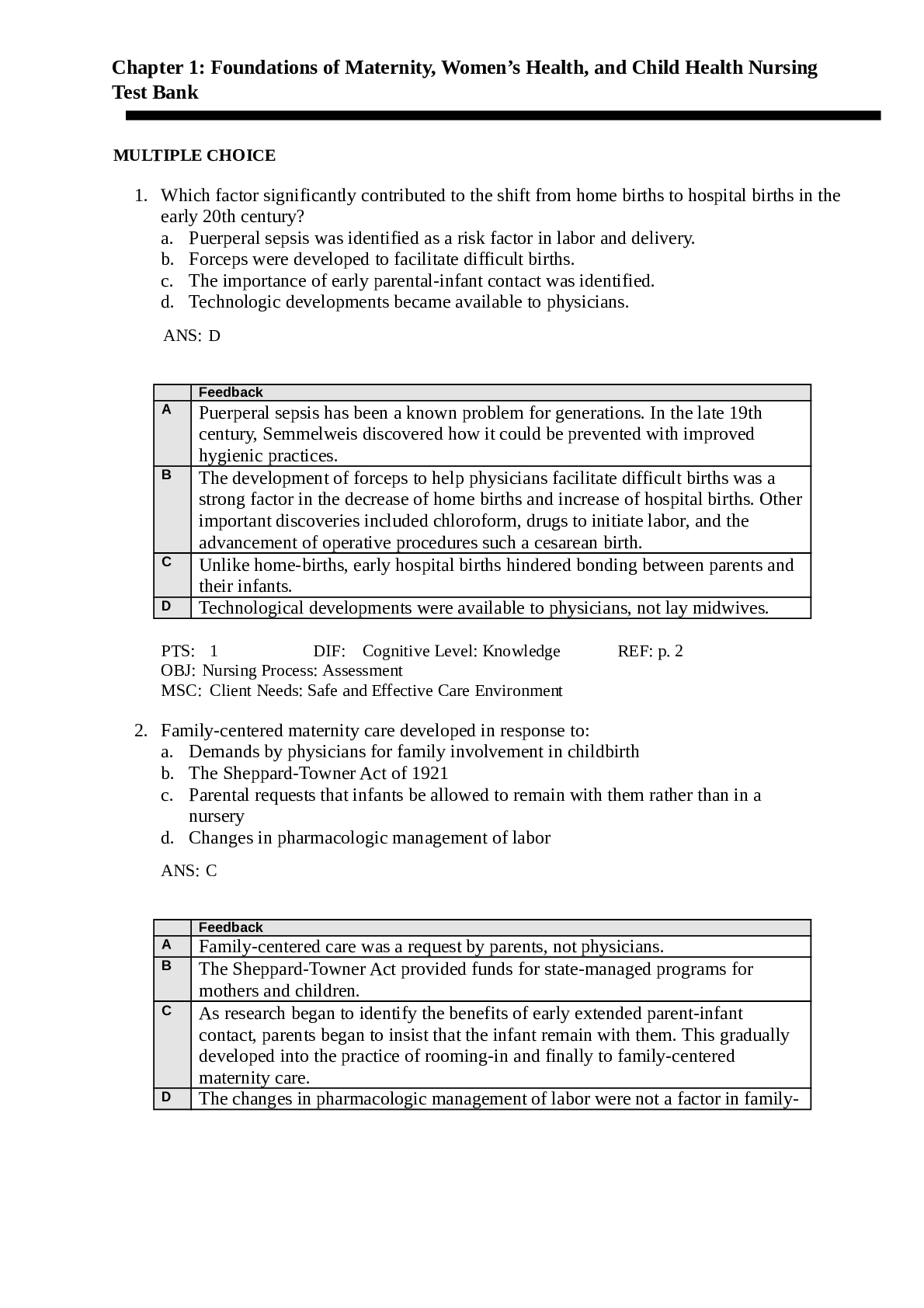
.png)
.png)

